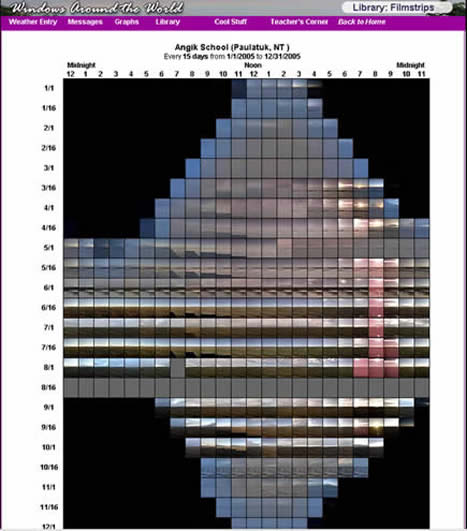Windows Around the World: Sensor Networks in the Classroom
On August 31 2007, teachers from the Rafael Hernandez School in Roxbury and the Sarah Greenwood School in Dorchester (both in the Boston Public Schools district) met at UMass Boston with Windows Around the World developer Juanita Urban-Rich for an Ocean Sciences Education Institute workshop. The Windows Around the World program is a visual, interactive, international educational tool for elementary students that has been running for three years. It is a web-based exchange program that promotes and fosters international collaboration, environmental science and cultural geography.

One example of how archived data from Windows Around the World can be used to illustrate a concept. This image shows the ratio of daylight to darkness for a one-year period, captured outside the Angik School, Paulatuk, Northwest Territories, Canada.
Some unique features of Windows Around the World are:
-
visual display of land and sky images captured hourly at each school with a web camera
-
customization of data entry for different grades (K-5/6)
-
dynamic graphing of student-collected data
-
inclusion of second languages
-
forum for dialog between students
-
display of student-produced work derived from data collected in the program
Data generated by Windows Around the World can be used to teach students about solar processes; season; ground cover in polar, temperate and tropical regions; geography; weather; climate; culture; language; technology; and mathematics. At the Sarah Greenwood School (a dual-language school with a science and technology focus), science and math specialist and OSEI participant Karen Scholz has developed a project (WIN: Weather Impacts Nature) that uses weather as a common language to build student writing skills and to increase comprehension and vocabulary. She has received a Toyota Tapestry Grant to implement this project, part of which will have students observing and collecting weather data and recording and writing about what they learn. When Karen heard about the Windows Around the World OSEI she thought it would be a great fit with what her school will be doing. The K2 class (teacher Gareth Lindwall) will be participating along with the 3rd grade (teacher Christina Rish), with the plan to include additional grades as the year progresses.
At the Rafael Hernandez School science teacher Erin Hashimoto will also be implementing curriculum based on Windows Around the World. ‘’It can be used to teach the scientific method, how to make observations,’’ said Erin. ‘’This is real stuff that they are really seeing! Plus it helps students learn the difference between weather and climate.’’ Windows Around the World can generate critical thinking activities, and contains three years of collected data for students to look at and learn from. In addition, the data generated by the participating schools is archived and is accessible for other non-participating schools to use and to learn about other regions.
Windows Around the World encourages global awareness through the different geographic locations of participating schools. ‘‘Students need to experience the technology that can connect distantly located places,’’ said project developer Juanita Urban-Rich. ‘’Students need to gain a sense of global community and to be aware of similarities and differences in countries and cultures.’’ Having schools in polar, temperate and tropical regions will help students gain a great global perspective of cultural geography and an understanding of earth science. Through OSEI, Windows Around the World will provide an exciting and stimulating means of allowing students to learn about different regions along with standard math, science, technology and geography concepts. ‘’It’s a way to start bringing it home and making it real for kids,’’ said Juanita. ‘’And it invites kids to just look out the window!’’
Participating teachers will implement their Windows Around the World-based curriculum during the fall and then will gather in December, along with all of this year’s OSEI participants, to report on results.

Windows Around the World serves both formal educators and the general public. With over 4000 visits a year, this program is letting people around the world see, learn and appreciate different regions and cultures of the world. The map shows the location of visitors to the site during 2006.
Get Involved
Contact the COSEE-NE Director at pdibona@neaq.org for more information on getting involved with the Ocean Science Education Institute.
Participants
To date, representatives from the following institutions, museums, educators’ associations,
conservation groups and school districts have participated in OSEI:
Institutions/Organizations
Woods Hole Oceanographic Institution (WHOI)
Gulf of Maine Institute (GOMI)
University of New Hampshire (UNH)
UMass Dartmouth
UMass Boston
University of Rhode Island (URI)
Bridgewater State College
Sea Education Association (SEA)
Massachusetts Audubon Society
Plum Island Ecological Long-Term Research (PIE-LTR)
Hands On Boat Based Education and Science
Parker River National Wildlife Refuge
Gloucester Maritime Heritage Center
Massachusetts Marine Educators Association
Captain John’s Boats
Northeastern University Marine Science Center
Schools
Boston Public Schools
Fairhaven Public Schools
New Bedford Global Learning Charter School
Chelsea Public Schools
Salem Public Schools
Newburyport Public Schools
Plymouth Public Schools
Swampscott Middle School
The OSEI team is led by Principal Investigator Bob Chen (UMass Boston) and Program Coordinator Kim Frashure (UMass Boston). They anticipate that this successful workshop model will have a lasting impact on middle school education and will serve as a successful model for ocean science workshops throughout New England.